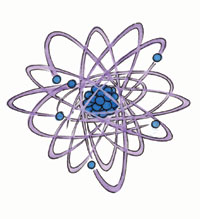Quantum Science: Exotic Relatives of Protons and Neutrons

Exotic relatives of protons and neutrons discovered
The finds help in understanding the forces that bind quarks into matter
SUB-ATOMIC PARTICLES called `quarks' are the building blocks of matter. Named `Sigma-sub-b' particles, two exotic and incredibly quick to decompose particles have been discovered by a team of researchers at Johns Hopkins University.
"These particles are members of what we call the `baryonic' family, so-called for the Greek word `barys,' which means heavy," team leader Petar Maksimovic, assistant professor of physics and astronomy in the university's Krieger School of Arts and Sciences said. "Baryons are particles that contain three quarks, which are the fundamental building blocks of matter." The simplest baryons are the proton and neutron, which make up the nuclei of atoms of ordinary matter.
Unstable, ephemeral
"These newest members of that family are unstable and ephemeral, but they help us to understand the forces that bind quarks together into matter," Maksimovic said.
Containing the second-heaviest quark — called "the bottom quark" — the new particles are the heaviest baryons found yet: heavier even than a complete helium atom, which has two protons, though lighter than a lithium atom, which has three, according to a Johns Hopkins University press release.
The team combed through a hundred trillion proton-antiproton collisions at the Tevatron, the world's most powerful particle accelerator, to find about 240 Sigma-sub-b candidates, Maksimovic said.
The new particles are extremely short-lived, decaying within a tiny fraction of a second.
"Little by little, we are compiling an ever-clearer picture of how quarks build matter and how subatomic forces hold quarks together and tear them apart," said Maksimovic.
While the matter around us is constructed with only up and down quarks, exotic matter contains other quarks as well, according to Maksimovic.
Six types
There are six different types of quarks: up, down, strange, charm, bottom and top (u, d, s, c, b and t). One of the new baryons discovered by the team is made of two up quarks and one bottom quark (u-u-b), the other of two down quarks and a bottom quark (d-d-b). For comparison, protons are u-u-d combinations, while neutrons are d-d-u. The Tevatron accelerates protons and antiprotons close to the speed of light and makes them collide. In the collisions, energy transforms into mass, according to Einstein's famous equation E = mc{+2}.
The odds of producing bottom quarks — which in turn transform into the Sigma-sub-b, according to the laws of quantum physics — are extremely low.
But scientists were able to beat the low odds by producing billions of collisions in the Tevatron each second.
Source: The Hindu
Tags:
Labels: Atomicity, Baryons, Quarks
 Stumble It!
Stumble It!



0 Comments:
Post a Comment
<< Home